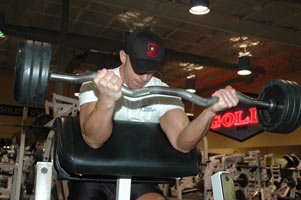Why is it that some workouts you just can't stimulate a blood-engorged muscle pump despite countless torturous sets and ultra-focused reps? The answer may not have anything to do with your training program, but more to do with your body's physiology.
Our bodies are pre-programmed with multiple complex homeostatic mechanisms that work to limit large increases in various chemical messengers, hormones and other cellular stimuli. These are typically considered safe and sensible built-in systems that protect us from reaching very high or very low levels of anything and keep us in a "normal" range.
The disadvantage to these pre-programmed mechanisms is that there are certain instances when you actually might benefit from having slightly elevated levels of chemical messengers for a short duration. This is particularly true for bodybuilders looking to maximize nitric oxide production for a skin-stretching muscle pump in the gym.
Understanding ADMA
Inside the endothelial cells of your body right now is a powerful biological factor that is fighting to prevent you from achieving a truly phenomenal muscle-building pump. This restrictive element is known in the scientific community as Asymmetric dimethylarginine (ADMA), which is an endogenous competitive inhibitor of endothelial nitric oxide synthase.
As a result of its inhibitory effects on nitric oxide synthase, ADMA is considered by researchers to be a key regulator of nitric oxide production and blood flow delivery to the muscles.
Overpowering The Limits Of ADMA
Since the golden era of bodybuilding, any serious trainer looking to add muscle knows and values the importance of achieving a maximally stretched, blood-saturated muscle pump. Many industry gurus believe that the more nutrients you can cram into muscle cells while you're training, the greater the anabolic signal you create for muscle growth to occur.
In addition, many experts also hypothesize that a fully engorged muscle pump may stretch the fascia that encapsulates muscles, further contributing to a powerful growth response.

 Click Image To Enlarge.
Click Image To Enlarge. Any Serious Trainer Values The Importance Of Achieving
A Maximally Stretched, Blood-Saturated Muscle Pump.
Many bodybuilders supplement with Arginine prior to a workout in an attempt to trigger vasodilation. Regular nitric oxide supplements that rely solely on Arginine as a primary driver for vasodilation work by triggering N.O. production through a chemical reaction that requires nitric oxide synthase as a critical element.
One of the problems with this approach is that when the ratio of ADMA to arginine increases, your body's nitric oxide production ability is severely limited, reducing the degree and intensity of the pump you're able to achieve in the gym. The sad thing is that most bodybuilders may be suffering from the restrictive fate of ADMA without even knowing it.
The Next Generation Of Nitric Oxide
Imagine an insane muscle-stretching pump every time you hit the gym. The type of workouts that stimulate unbelievable myo-expansion effects with every set until every muscle belly is hyper-engorged to max physiological levels. That's exactly what an innovative group of researchers set out to deliver when they developed an extreme-strength pre-workout muscle growth and performance amplifier.
Featuring an exclusive technology that works with seven strategically formulated blends, every dose is designed to overwhelm the N.O. limiting effects of ADMA to maximize muscle pumps and redefine the next generation of bodybuilders.
Feedback from the first group of hardcore bodybuilders to experience this new formula is already being received and the results are like nothing they've ever experienced in a regular pre-workout formula. Put simply, if you haven't experienced a pump without the limits of ADMA, you don't know what you're missing.
